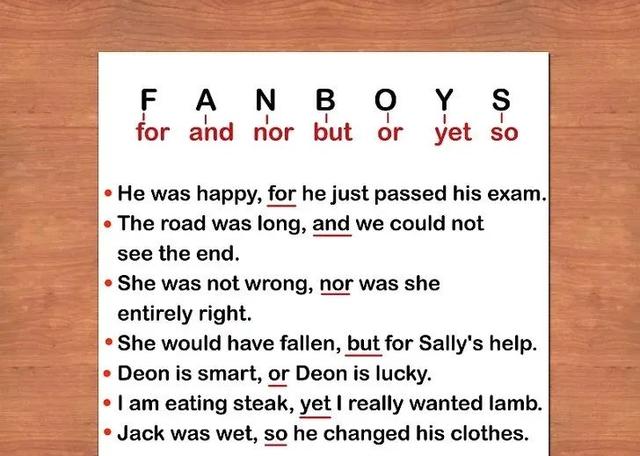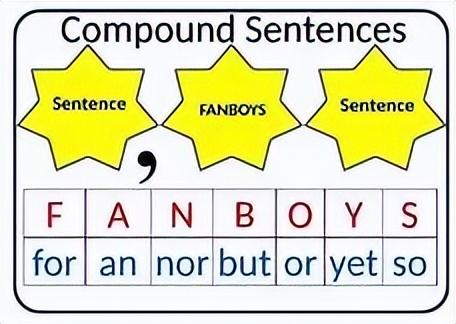1. Define a compound sentence. 什么是并列句
A compound sentence is made up of two simple sentences. The two simple sentences are joined by a comma (,) followed by one of seven words called coordinating conjunctions. The seven coordinating conjunctions are: for, and, nor, but, or, yet, so. To help you remember, use the mnemonic FANBOYS. Here are some examples of compound sentences. Note the use of the coordinating conjunction.
并列合由两个简单的句子组成。两个简单句之间由逗号隔开,逗号后的分句由并列连词连接。并列连词有7个,它们是:for由于,and和,而且, nor 也不是,but但是,or或者,so所以。为了帮助您记住,请使用助记符 FANBOYS。下面是一些复句的例子。请注意并列连词的使用。

- He was happy, for he just passed his exam.
- 他很高兴,因为他刚刚通过了考试。
- The road was long, and we could not see the end.
- 路很长,我们看不到尽头。
- She was not wrong, nor was she entirely right.
- 她没有错,也不完全正确。
- She would have fallen, but Sally helped support her.
- 她本来会倒下的,但萨莉帮她支持。
- Deon is smart, or Deon is lucky.
- 迪恩很聪明,或者他是幸运的。
- I am eating steak, yet I really wanted lamb.
- 我在吃牛排,但我真的很想吃羊肉。
- Jack was wet, so he changed his clothes.
- 杰克身上湿了,所以他换了衣服。

2. Try writing a compound sentence. 试着写一个并列句。
Begin by choosing a subject and a verb for the first part of the sentence, the same way you did while writing a simple sentence. Next, choose the appropriate coordinating conjunction based upon the meaning of the sentence. Finally, choose a related subject and verb for the second part of the compound sentence.
首先,就像写一个简单的句子时一样,为句子的第一部分选择一个主语和动词。接下来,根据句子的含义选择适当的连词连接。最后,为并列句的第二部分选择相关主语和动词。

- You may want to use "and" to express a continuing thought or meaning, or you can use "but" as part of an explanation. There are many possibilities.
- 使用 "和"来表达持续的想法或含义,或者使用"但"作为解释的一部分。有很多选择。
3. Pay attention to meaning when writing a compound sentence.
写复句时要注意意思。
By writing compound sentences, you can greatly expand on the meaning of the sentence when compared to a simple sentence. Be sure to use the second part of the sentence to expand or elaborate upon the thought expressed in the first part.
与简单的句子相比,写并列句,可以很大程度上扩展句子的含义。请务必使用句子的第二部分来扩展或阐述思想。
- Be careful not to overuse compound sentences, particularly those that use "and." They do not always indicate a clear relationship and may seem cluttered.
- 不要过度使用并列句,尤其是那些使用"和."的句子,它们并不总是表示关系明确,而且可能让句子看起来杂乱无章。
4. It’s also possible to combine two independent clauses without a conjunction. In that case you would use a semicolon instead of a comma to separate them.
也可以不用连词把两个两个独立的简单句连起来。在这种情况下,需要用分号而不是逗号来分隔它们。
比如:Larry watches the news. Bill makes news.
可以改写成:
1)Larry watches the news, but Bill makes news.
或者
2)Larry watches the news; Bill makes news.
一试身手:
用并列句改写下面的句子. (Answers at the bottom of this page.)
1. I have studied Spanish for many years. As a result, my Spanish-speaking friends can chat easily with me now.
2. You are quite intelligent. However, you don’t think before you act.
3. My friends Jesse and Jennifer have just moved into a new home. They’ve made many changes in its appearance.
4. Susie could study music next year. She could study drama instead.
5.I like ice cream. He prefers butter.

答案:
1.I have studied Spanish for many years, so my Spanish-speaking friends can chat easily with me now.
2. You are quite intelligent, but you don’t think before you act.
3. My friends Jesse and Jennifer have just moved into a new home, and they’ve made many changes in its appearance.
4. Susie could study music next year, or she could study drama (instead). (You can omit ‘instead,’ or leave it in the sentence for greater emphasis.)
5. I like ice cream; he prefers butter.
,




